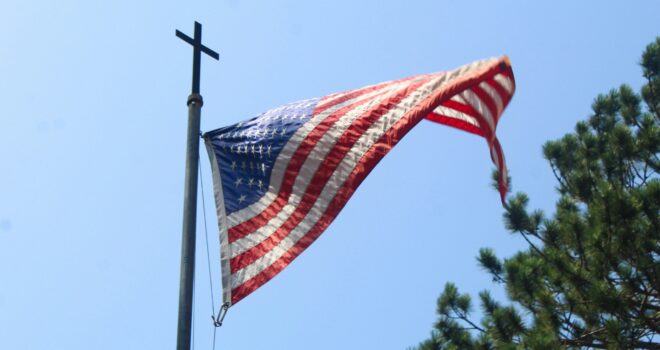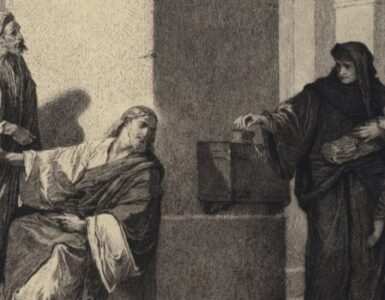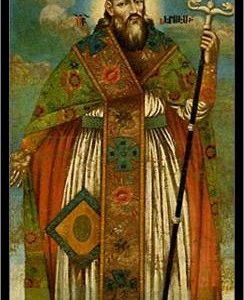When we think about the concept of civil war in the United States, our mind inevitably conjures up images of the American Civil War of 1861 to 1865—ranks of marching men in blue and grey, cannons and musket fire erupting across open fields, and generals with incredibly oversized beards. The American Civil War was such a monumental conflict that it has become impressed upon our collective memory as the quintessential template for civil strife.
You may be surprised to learn, however, that the first civil conflict in our country happened over two hundred years before the Civil War and was fought over Catholicism. The story of this little-known conflict takes us back to the English colony of Maryland during the turbulent years of the mid-seventeenth century, when Protestants and Catholics struggled against one another for control of the lands around the Chesapeake.
The colony of Maryland had a stormy history. It was chartered in 1632 by King Charles I, who granted the uncultivated lands north of the Potomac to his friend George Calvert, Lord Baltimore, to be ruled as a proprietary colony (i.e., a personal domain). Calvert, a Catholic, thought the new colony could serve as a refuge for English Catholics who, living in Protestant England, were subject to harsh legal restrictions on their work and worship. The colony could be an opportunity for Catholics to live and worship free of the prejudices they encountered in England.
The new colony was to be called Maryland, ostensibly after the Princess Henrietta Maria but really in homage to the Blessed Virgin Mary, the patroness of the endeavor. The first settlers arrived in 1634 on two ships called the Ark and the Dove. Lord Baltimore could not find enough Catholics to relocate, however, and consequently Protestants were chosen to fill in the gaps (this would cause considerable headaches for the Calverts in the future). The colony was to be administered by Leonard Calvert, son of the original Lord Baltimore.
Troubles began almost immediately. The neighboring colony of Virginia resented the presence of this upstart settlement across the Potomac. Protestant militias from Virginia frequently raised Maryland’s frontiers, plundering Catholic farms and even kidnapping priests sent to minister to the families there.
Of particular controversy was Kent Island, the largest island on Chesapeake Bay. The royal charter of 1632 granted this island to Maryland, but a Virginia planter named William Claiborne had already established a trading post there and claimed the land for Virginia. Claiborne stirred up all manner of trouble for Maryland, even running Leonard Calvert out of the colony briefly. Claiborne also encouraged the migration of Puritans into Maryland who, once settled, agitated the government of the Calverts in an attempt to undermine their power.
Back in England, the English Civil War broke out in 1642, pitting Puritan Parliamentarians against the Anglican Royalists loyal to Charles I, a conflict that would see Charles dethroned and beheaded.
As England fell to the Puritan dictatorship of Oliver Cromwell, the conflict spilled over into Maryland as well. Emboldened by Cromwell’s victories, Puritans attempted to take over the colony. By this time Calvert was dead, and the new governor was William Stone, a Protestant who nevertheless supported the Calverts and the rights of Catholics. Stone and the Calverts had promulgated the Maryland Toleration Act of 1649, granting religious liberty to all Christians in Maryland in the first official declaration of religious toleration anywhere in North America. Infuriated by this, the Puritans ousted Stone and took control of the colony in 1652. The Toleration Act was repealed, Catholic worship was outlawed, and William Claiborne was made Parliament’s special commissioner in Maryland.
Catholicism was now prohibited in the very colony meant to be a Catholic refuge. Governor William Stone was not ready to throw in the towel yet, however. Mustering his troops (most of them Catholics) Stone sailed up the Chesapeake Bay in March of 1655 towards the newly founded town of Providence, modern-day Annapolis. Providence was a hot bed of Puritan activity and the base of Claiborne’s operations. Stone hoped to put an end to the Puritan insurrection with a single blow, depriving them of their headquarters and taking Claiborne into custody.
Word of the invasion made it to Providence, however. The city was evacuated, and a military force was hastily assembled under the command of one Captain William Fuller, leader of the Providence militia. On March 24th, Stone’s ships were sighted entering the inlet of the Severn River, north of Providence. Fuller’s ships opened fire on them, driving them towards the shore. Stone’s troops formed up on Horn Point, a peninsula in the present-day neighborhood of Eastport, Annapolis. The forces were small—Stone commanded 132 men, and Fuller 170. Weaponry was mixed, with pikes, polearms, and swords being used alongside muskets and arquebuses. Fuller’s troops moved on to the peninsula and engaged Stone, commencing the Battle of the Severn.
The fighting was fierce, but brief. Stone’s force proved no match for Fuller’s, whose relentless onslaught drove the Catholic militia back, bottling them up at the end of the peninsula. The fighting was over in a half hour, during which time seventeen of Stone’s men were killed and over thirty wounded; only two were killed on Fuller’s side. Stone surrendered in exchange for his life.
Thus was the Battle of the Severn, the first civil conflict fought on American soil. Despite the promise of mercy, the war council of Providence sentenced Governor Stone and nine others to death. Four of Stone’s men were executed before the remaining sentences were commuted, due to the pleas of the women of Providence. Stone barely escaped with his life.
The Puritans remained firmly in control of Maryland until 1658 when the Calvert family was restored. Even William Claiborne was pacified; Lord Baltimore granted him amnesty for all crimes committed during the war and paid him a hefty indemnity in exchange for Virginia abandoning its claims to Kent Island.
Sadly, this was not the end of the hostilities between Puritans and Catholics in Maryland. By 1689 the colony was again in Puritan hands and Catholicism was outlawed, this time until the founding of the United States.
The story of the 1655 Battle of the Severn reminds us that, long before slavery or other issues split Americans into factions, our original civil strife was about the rights of Catholics.










